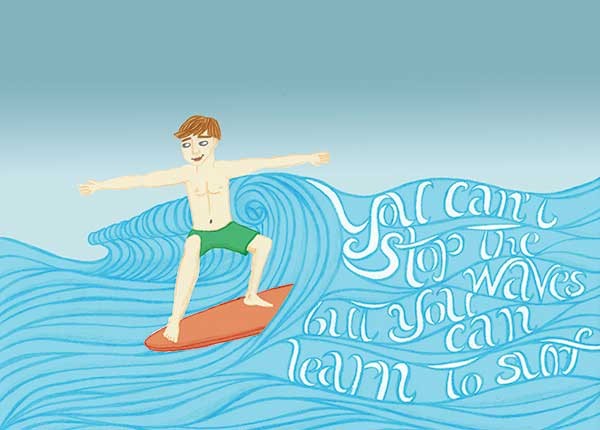Ernest Shaw, MD, is asking me to stare at a raisin. "Look at it like you're from Mars, like you've never seen a raisin before," he instructs. "What do you see?" Less than an hour ago I was stranded in West Hurley, my car lodged in a shrub after careening off-road over the first snowfall of the season. But now, in a conference room in Kingston—eons away from AAA, a winch, and a pickup truck—I am descending into the amber crevices and otherworldly ridges of a golden raisin sitting in my palm.
About a dozen other students surround me, also communing with wrinkled fruit. After several minutes, Shaw invites our Martian observations about the raisin's look, feel, and scent—from the brainlike folds of its form to the sticky residue it leaves on the skin. Then he instructs us to put the raisin in our mouths but not to bite it. I hold it on my tongue and let it roll around for what feels like an age—a kind of long, slow gustatory foreplay—bringing my attention to realms of texture and taste I never knew existed in a Sun-Maid box. Eventually, Shaw tells us to crush the raisin gently with our teeth, releasing a sweet explosion—then to linger here for a while before allowing the ragged, wine-like fragments to slide down our throats. We are to feel and note every sensation before the fruit disappears into digestive oblivion.
The raisin meditation, I discover later, is a classic way to begin a course in Mindfulness-Based Stress Reduction (MBSR)—first developed by Jon Kabat-Zinn at the University of Massachusetts Medical School in 1979, and now taught by instructors like Shaw in cities across America. Kabat-Zinn, a professor of medicine with Buddhist training, originally created the course to help patients cope with chronic pain. Their treatment would not be drugs or anesthesia but a powerful salve known to monks, sages, and rishis across the ages: moment-to-moment awareness.
It's Kabat-Zinn who helped bring mindfulness—or deep awareness of the present moment—into the mainstream, secularizing the age-old practice and applying it as a practical tool for meeting the challenges of what it means to be human. Today, mindfulness is one of science's hottest research subjects—a pet favorite of laboratory luminaries like Richard J. Davidson, professor of psychology and psychiatry at the University of Wisconsin-Madison. In 2003, Davidson conducted a study with brain scans taken before and after subjects completed an eight-week training in mindfulness meditation. The "after" scans showed increased activity in the left prefrontal cortex, the center for feelings of calm and wellbeing. Davidson's subjects also demonstrated better immune function. Since this study, hundreds more have cropped up (a search on PubMed brings up over 900 records)—and mindfulness has made in-roads in the fields of cognitive therapy and psychological intervention with broad applications, from bipolar disorder to chronic fatigue syndrome.
Tools for Living
The promise of stress reduction might bring people into the door of a classroom like Shaw's, but stress here is a blanket term for whatever it is that ails you. Embarking on the raisin journey with me are an 86-year-old woman facing the trials of aging, a teenager with pangs of insecurity, a middle-aged couple in the wake of a health crisis, and an empty-nester who feels mired in a sense of purposelessness.We think we're alone on our little islands of mental or physical pain, but we're not—that's one lesson from an MBSR class, and it's an important one. Like a survival guide, the course is presenting us with a toolbox of strategies including meditation, body scans, breath awareness, Hatha yoga, and plenty of knock-some-sense-into-you discourses from our instructor—in this case, a Bronx-accented septuagenarian who doesn't mince words. "When a tree loses its leaves, we don't say that it's fucked up. When a river is frozen, we don't say that it's broken. Yet we do these things to ourselves," says Shaw, a psychiatrist. "We're far harder on ourselves than anybody else would be. We need to give ourselves a break, because we're doing a better job than we think of being human."
Systematically, Shaw leads us back to what many spiritual teachers describe as the root cause of suffering: our whirling-dervish minds. Much of the time, our minds wander; we ruminate, we worry, we're anxious, we're regretting. We think about the past or the future—anything but the present moment. As a result, says Shaw, "We start to feel disconnected from the world. So we look for addictions to fill us, like food or sex or money, and we look for love to complete us. Disappointment comes in, because none of these strategies can work for long." Going back to the raisin, Shaw begins to tease out a world of observations—from the indentation where the fruit once connected to the vine, to the sun and the rain that helped it grow, to the lives of dozens of people involved in its harvesting and production, including the driver of the truck that delivered the raisin to the local store. "When you really pay attention, when you're really in the moment, you see that nothing is disconnected. It's all part of the order of things. In the moment, we're connected to everything."
Riding the Waves
It's often some of life's biggest challenges that bring people to mindfulness in the first place. Stephanie Speer, an MBSR teacher based in Stone Ridge, was going through a divorce when she signed up for a five-day program that incorporated mindfulness practices at the Omega Institute in Rhinebeck. The course helped her find a greater ease of being that she could carry through good times and bad. "There's a phrase that's often used: 'You can't stop the waves but you can learn how to surf,'" says Speer. "We all have these challenges, these stressors. With mindfulness we can meet them with more ease. For some of us, we're under the delusion that if everything gets aligned in our lives, then we'll be happy. We think that's where happiness is—dependent on external circumstances. If we're waiting for that, then we're probably going to be very unhappy. There's always going to be stuff. If you have a mind and a body and you live on this planet, there are going to be difficulties."When Lynn Cramer, a retired computer programmer in Poughkeepsie (whose name has been changed for anonymity), took Speer's MBSR class in 1998, she'd been battling depression and having trouble with her grown kids. "It really woke me up," says Cramer about the course. "It opened so many doors for me." She delved deeper with weekly group meditation sits, yearly retreats, and books by American Buddhist nun Pema Chödrön. When Cramer was diagnosed with cancer in 2002 and underwent four surgeries, she drew on her practices to stay grounded. "I can't imagine going through something like that without mindfulness," she says. "In general, I've become so much more nonjudgmental and forgiving and compassionate. Little things that might bother me don't bother me anymore. I can see things, understand things, that I never was able to see before." Yet Cramer is careful not to give newcomers to the practice unrealistic expectations. "It's not like you're euphoric. You still feel pain and everything. But somehow it's enabled me to focus on 'What can I do?' instead of 'Why me?'" Cramer still takes medication for depression, noting that Western medicine has its place and mindfulness is not a cure-all. "But I attribute all of my personal growth to the mindfulness, not to the medication. I don't think the medication would help me forgive my mother," she says with a laugh.
Beyond "Monkey Mind"
In Shaw's next exercise, we are to practice sitting meditation for three minutes, bringing the same deep curiosity to our thoughts and sensations as we did to the raisin. "That was hard—my mind was all over the place," says one student afterwards. "That's okay," says Shaw. "We're learning to become the observer. The work of mindfulness lets you see, 'Oh, I'm worrying' or 'Oh, I'm regretting'. When you become the observer of your thoughts, you can disidentify with those thoughts." Our goal with meditation, he suggests, is not necessarily to still the mind. The point is not to get caught up in our thoughts—especially the negative stories we tell ourselves. "With one finger we can blot out the world," says Shaw. "That's what we do with our thoughts. If you have a thought like, 'My life's a failure' or 'I'll never find love' or 'My kid's a disaster,' that one thought can blot out your life. Sometimes what we tell ourselves isn't so. The present moment is not as terrible as what we're telling ourselves with our story." If we sit and observe long enough, Shaw suggests, we discover that all things observable—including our thoughts—are impermanent. They arise and pass away. Once we realize this, our thoughts have less power over us.For homework, we are to practice mindfulness with something simple: getting dressed, taking a shower, eating ("Not every time you eat," jokes Shaw, "or people will think you're crazy"). Speer, too, counsels her students to have a daily practice. "It could be a walking meditation; it could be your cup of tea," says Speer. "I have one client who uses her swimming routine—feeling the water, noticing the aroma. What we're doing is cultivating what I call our mindfulness muscle. Then it leaps over into our personal lives and we're able to, for instance, be more responsive to our children and less reactive."
Connecting to What's Real
Just as most MBSR courses begin with the raisin meditation, many end with exercises that focus attention on relationships. "We learn to be present for the person who is in front of us," says Speer. "Oftentimes we pay the least attention to the people who are most familiar to us in our personal life. We have a lot of past experiences and assumptions, so we're not really being present with them." One student, recalls Speer, came to her MBSR class because he'd had a heart attack and was looking to reduce stress. An unexpected benefit for him was an enriched relationship with his wife when finally, in their golden years, he learned to be fully present with her."We often don't see ourselves, or our spouses and the people we're close to, because we're caught up in our thinking," says Shaw. "We don't see the world because we're caught up in our ideas of the world. Mindfulness lets us get real. We don't need special experiences and places to wake up—we can do it through a raisin, or petting our dog, or washing the dishes. We're not going to live on a mountain meditating. We need to really use it to live our lives."
Resources
Ernest Shaw, MD (845) 331-1155Stephanie Speer, MA


















